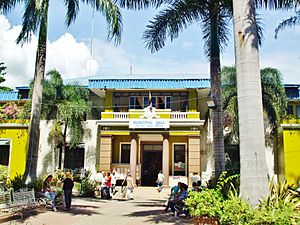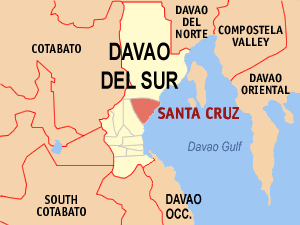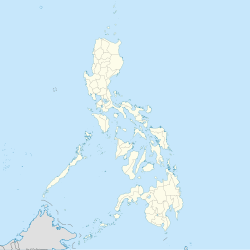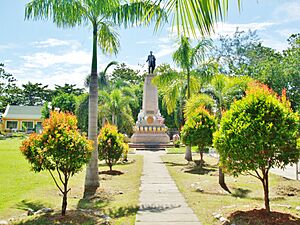Santa Cruz, Davao del Sur facts for kids
Quick facts for kids
Santa Cruz
|
|||
|---|---|---|---|
| Municipality of Santa Cruz | |||

Municipal Hall
|
|||
|
|||

Map of Davao del Sur with Santa Cruz highlighted
|
|||
|
OpenStreetMap
|
|||
| Country | Philippines | ||
| Region | Davao Region | ||
| Province | Davao del Sur | ||
| District | [[{{#property:P7938}} | — Lua error in Module:Wd at line 1804: attempt to index field 'wikibase' (a nil value).]] | ||
| Founded | October 5, 1884 | ||
| Barangays | 18 (see Barangays) | ||
| Government
|
|||
| • Type | Sangguniang Bayan | ||
| Area | |||
| • Total | 319.91 km2 (123.52 sq mi) | ||
| Elevation | 53 m (174 ft) | ||
| Highest elevation | 539 m (1,768 ft) | ||
| Lowest elevation | 0 m (0 ft) | ||
| Population
(2020 census)
|
|||
| • Total | 101,125 | ||
| • Density | 316.105/km2 (818.707/sq mi) | ||
| • Households | 26,424 | ||
| Economy | |||
| • Income class | 1st municipal income class | ||
| • Poverty incidence |
|
||
| • Revenue | ₱ 628.2 million (2022) | ||
| • Assets | ₱ 2,026 million (2022) | ||
| • Expenditure | ₱ 444.1 million (2022) | ||
| • Liabilities | ₱ 1,082 million (2022) | ||
| Service provider | |||
| • Electricity | Davao del Sur Electric Cooperative (DASURECO) | ||
| Time zone | UTC+8 (PST) | ||
| ZIP code |
8001
|
||
| PSGC |
[https://psa.gov.ph/classification/psgc/?q=psgc/barangays/{{#pro000®code={{&provcode=
|
||
| IDD : area code | +63 (0)82 | ||
| Native languages | Davawenyo Cebuano Obo Kalagan Tagalog Ata Manobo |
||
| Website | stacruz |
||
Santa Cruz is a lively town in the Davao del Sur province of the Philippines. It's officially known as the Municipality of Santa Cruz. In 2020, about 101,125 people lived here. Santa Cruz is also part of Metro Davao, a large urban area, because it shares a border with Davao City.
Contents
History of Santa Cruz
Santa Cruz is the oldest town in its province. It was founded on October 5, 1884. This was 36 years after Davao, its "mother city," was established by Don José Uyanguren from Spain.
Early Spanish Settlements
In the 1880s, Spanish explorers and missionaries tried to settle in the area. This is now known as Barangay Poblacion. The local people had a strong Islamic faith. Because the missionaries could not convert them to Christianity, they put up a cross under a shelter. This cross marked their failed efforts. The town's name, Santa Cruz, means "Holy Cross" in Spanish. Later, more locals became Christian. Angel Rodriguez, the Spanish Governor-General of Davao, took control of the area. Like Davao, Santa Cruz did not grow much for about 20 years.
American Influence and Growth
Americans arrived in Davao in the early 1900s after Spain lost the Spanish–American War. About 14 years later, Santa Cruz started to grow economically. However, its neighbor, Davao, grew much faster. On March 16, 1936, Davao became one of the first two cities in Mindanao. This was due to its quick economic and agricultural growth.
World War II and Recovery
In 1942, the Japanese invaded the Philippines. Santa Cruz suffered a lot during the Japanese occupation. Davao, however, continued to grow. Local Filipino fighters and army troops kept attacking the Japanese forces. In 1945, Filipino and American soldiers fought together. They freed the town from Japanese control. After the war, many people moved to Davao for better jobs. Even so, Santa Cruz continued to grow, though at a slower pace.
Changes in Town Borders
Almost three years after the Philippines became independent in 1946, two new towns were formed from Santa Cruz. These were Padada (July 15, 1949) and Digos (July 19, 1949). In the 1960s, a new town called Roxas was planned. It would include areas like Inauayan and Sibulan. However, the Supreme Court of the Philippines stopped this plan. They said it would cause problems for Santa Cruz. In 1967, Digos became the capital of the new Davao del Sur province. Later, Digos became a city and is now the most populated city in the province, not counting Davao City.
Dream of Becoming a City
On October 5, 2013, during its 129th anniversary, Santa Cruz leaders hoped the town would become a city. This is because big companies like San Miguel Corporation are located there. The mayor, Joel Ray Lopez, said they wanted it to become a city soon. Santa Cruz has improved its buildings and roads. It has also met most of the requirements to become a city, like income and land area. If Santa Cruz becomes a city, more industries are expected to develop there.
Geography of Santa Cruz
Santa Cruz is located in the northern part of Davao del Sur. It borders Davao City to the north and Digos City to the south. After some parts were separated, Santa Cruz now has about 27,960 hectares of land. This is about 6.7% of Davao del Sur's total land area. Forests cover 60% of the land. The town also has 8 coastal barangays (villages).
Land Area Details
The official land area of Santa Cruz is 27,960 hectares. However, local records show it might be closer to 28,759.7855 hectares. This is about 7.31% of the province's area. The largest barangay is Sibulan, covering 6,390.6581 hectares. Poblacion Zone III is the smallest, with only 105.3148 hectares.
Mountains and Plains
Santa Cruz has many mountains and high areas. Part of Mount Apo, the highest mountain in the Philippines, is located here. The rugged central area gradually slopes down to the coastal plains. These plains are in the northeastern, eastern, and southeastern parts of the town. Along the coast of Davao Gulf, you can see many coconut plantations and settlements. To the west, a plateau stretches towards Barangay Kapatagan of Digos. The town's elevation ranges from 10 to 2939 meters above sea level.
Climate of Santa Cruz
Santa Cruz has good weather all year round. It has both wet and dry seasons. The town is also outside the usual path of typhoons. Generally, November to April are dry months. The wet season is from May to October. This weather pattern is common in the plains and coastal areas. In the mountainous barangays, rainfall is spread more evenly throughout the year. Often, heavy rain falls in the afternoon, and the sun shines in the morning.
Barangays (Villages)
Santa Cruz is divided into 18 barangays. Each barangay has smaller areas called puroks, and some have sitios.
- Astorga
- Bato
- Coronon
- Darong
- Inawayan
- Jose Rizal
- Matutungan
- Melilia
- Saliducon
- Sibulan
- Sinoron
- Tagabuli
- Tibolo
- Tuban
- Zone I (Poblacion)
- Zone II (Poblacion)
- Zone III (Poblacion)
- Zone IV (Poblacion)
Demographics
Languages Spoken
The main languages spoken in Santa Cruz are Davaoeño, Tagalog, Mansakan, and English.
Economy of Santa Cruz
| Source: Philippine Statistics Authority |
|
Santa Cruz has a strong economy based on several key areas.
- Agriculture: Coconut is the top crop produced here. Bananas and sugarcane are also very important. Other major crops include corn, coffee, and various vegetables. The town also grows valuable fruits like mango, lanzones, and durian. Cattle farming is a leading livestock activity.
- Fisheries: Santa Cruz has a 24-kilometer coastline along Davao Gulf. This area is rich in fish and is perfect for aquaculture, which is farming seafood.
- Mining: There are deposits of sulfur ore, rock phosphate, guano, limestone, and materials for cement. These resources are waiting to be used for business and industry.
- Forestry: Large areas of timberland and forest are covered with tropical evergreen trees and other valuable timber. Rattan, bamboo, and other vines are also plentiful.
- Major Industries: The main industries in Santa Cruz are related to bananas, coconuts, and seaweed cultivation.
Tourism in Santa Cruz
Santa Cruz is a popular place for tourists in Southern Mindanao. It is known for its eco-cultural and adventure tourism. The town works with private businesses and the government to protect the environment.
- Sibulan - Mount Apo Trail: In 1880, a group led by Don Joaquin Rajal successfully climbed Mount Apo for the first time using the Sibulan Trail. When you trek this trail, you can try to climb the Boulder Face to reach the summit of the Philippines' highest peak.
- Sibulan River White Water Tubing: You can ride down the Sibulan River rapids on inflated rubber tubes. The strong water current will give you an exciting adventure!
- Tibolo Cultural Village: Here, you can learn about the unique culture of the indigenous Bagobo-Tagabawa Tribe. You can also enjoy amazing views of Mount Apo and the scenery of Davao City and Davao Gulf.
- Bato and Tagabuli Seascape: Passig Islet in Barangay Bato and the Tagabuli Sea Rock Garden have white sand beaches. They are great for island hopping, scuba diving, and fishing. You can also see how the mountain and coastal ecosystems are connected.
Other beautiful places to visit include the Passig Islet Agro Eco Park and Tudaya Falls.
Events and Festivals
- Pista sa Kinaiyahan: This event happens every last week of April. It's a way to honor Mother Nature. People plant trees, clean up areas, and take part in the Boulder Face challenge.
- Araw ng Santa Cruz: This festival is celebrated every October 5. It marks the day the municipality was officially created in 1884. The celebration includes parades, field demonstrations, trade fairs, carnivals, and traditional festivities. October 5, 2024, was a special non-working day for its 140th anniversary.
- Sinabbadan Festival: This festival, held every September, features ethnic rituals and dances.
Transportation in Santa Cruz
Santa Cruz is easy to reach by land. Vehicles travel on the national highway that goes through 11 of its barangays. This highway connects Davao to Digos, Kidapawan City, Cotabato City, Koronadal City, and Tacurong City.
Santa Cruz is about 38 kilometers from Davao City, which is the main center of Region XI. This is about a 45-minute drive. It's also only about 16 kilometers, or a 15-minute ride, from Digos, the provincial capital.
You can access air and water transport through the international airports and seaports in Davao City. For land travel, the Santa Cruz Overland Transport Terminal serves the town. The main highway is paved with concrete. It links Santa Cruz to Davao City and General Santos City, as well as nearby provinces. Jeepneys and buses are widely used for longer routes. Inside the town center (poblacion) and nearby barangays, tricycles are common. Bikes are used for fun and sports.
Notable People from Santa Cruz
- Nesthy Petecio: An Olympic medalist in boxing.
- Ronald dela Rosa: A politician and former police general.
See also
 In Spanish: Santa Cruz (Dávao del Sur) para niños
In Spanish: Santa Cruz (Dávao del Sur) para niños






